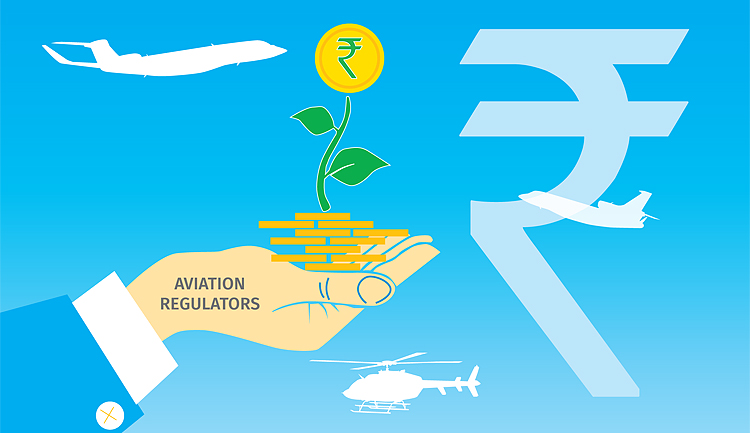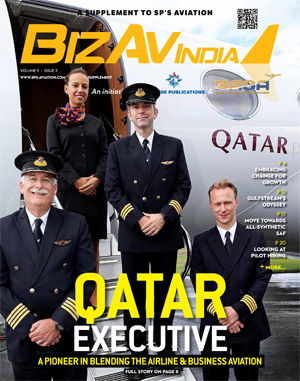Flight Path to Prosperity
It is imperative to unlock the potential and boost General/Business Aviation (GA/BA) to support the growth of aviation in India
 | By HARSH VARDHAN SHARMA PRESIDENT, BAOA |

India is poised to become the 3rd largest economy in the World and evidently our commercial airlines showing significant growth, with plans to induct hundreds of aircrafts in the coming years. On the other hand, the growth in General/Business Aviation is sadly stagnant and facing serious challenges. The growth in GA/BA sector is necessary to have potential benefits to our growing economy. To address this issue effectively, it is essential to develop a vibrant general aviation sector that can provide employment opportunities for aspiring Pilots, Engineers, Technicians and develop a robust MRO sector. This article explores the current state of general aviation in India and compares it to the thriving aviation industry in Europe and the United States where GA/BA is an integral part of their growth. The power and value of mobility can be fully seen. In the United States and Europe, the ratio of commercial aviation to general aviation stands at approximately 1:10. In contrast, India faces a starkly different scenario. According to estimates by the Directorate General of Civil Aviation (DGCA), India’s general aviation fleet comprises only around 800 small aircraft, including helicopters. Approximately 20 per cent of these aircraft are more than 25 years old and may not be operational. The ratio of commercial airline aircraft to general aviation aircraft is nearly 1:1, even when including both private and commercially employed small aircrafts. This imbalance hinders the development of aviation sector in general.
POTENTIAL CONTRIBUTIONS GA/BA SEGMENT CAN MAKE
- Provide much-required power and value of mobility to large corporates. It also provides them unique competitive edge in today’s global highly competitive economy.
- Currently, most of the Himalayan states are seriously lacking and waiting for the remote or the “last mile connectivity”. The Ministry of Civil Aviation is making great efforts to address the issue but hardly any progress has been made. The present NSOP Operators, who are already operating in such regions, are the best equipped to develop and serve the requirement. But they need to augment their size of fleet and manpower.
- The much-required EMS (Emergency Medical Services) not just in difficult terrain but also in plains.
- Import suitable aircrafts required for Aerial work to cater the construction of Ropeways, Powerline, Mapping and Airborne geophysical surveys. Unfortunately, currently the foreign registered aircrafts are being imported under NSOP permits on Wetlease to carry out such projects.
- The requirements, by the Defence establishments and the para-military forces to carry personnel, machinery, and goods are floated regularly for helicopters. But unfortunately, those requirements have not been met by the NSOP operators due lack of fleet strength.
- Disaster Relief- Often Governments demand helicopters for transportation from and to affected areas to save lives and provide relief material to those stranded.
CHALLENGES HOLDING BACK GA/BA INDUSTRY IN INDIA
Importation Costs: The long pending demand, by the NSOP Operators, of abolition of 2.5 per cent import duty, was imposed in 2008, has proved beyond doubt that it is the first major impediment in acquiring an aircraft. It is a substantial financial expense imposed on a Capital Good. The feasibility of the general aviation segment depends on affordable acquisitions just as in the case with commercial scheduled airlines who pay Zero import duty.
- 18 per cent GST on Pilgrims taking Helicopter shuttles: Helicopter shuttle service in economy class on per seat basis to the destinations like Mata Vaishno Devi, Amarnath ji, Kedarnath ji and to the other destinations has grown exponentially over the last 20 years. Currently, hundreds of thousands of Pilgrims travel every year. The average ticket costs approximately 3,000/-. Ironically, even after six years, after the introduction of GST regime, there remains a confusion in the basic understanding of the provisions. The latest demand notices by the State GST Department, served on the Helicopter Operators are suggesting levying 18 per cent GST on the Pilgrims. This is not only discriminatory but also contradictory since the Pilgrim taking Kailash Mansarovar Yatra are being charged only five per cent. Why Pilgrims must be subjected to 18 per cent when a normal passenger in a schedule airline is charged only five per cent?
- It’s high time that India needs to develop its own Financial Leasing ecosystem. Our dependence on offshore leasing companies is the second major impediment. The Banking Regulation Act needs to be amended so that the Indian Banks can facilitate lease financing. This step will not only bring the indirect operating cost considerably down but will also help in bargaining better cost with Aircraft and Engine manufacturers. The IFSCA needs to work in more collaborative approach with trade and regulatory authority.
- ATF must be brought under GST purview to provide uniformity across India.
- The Remote Connectivity or the “Last-mile Connectivity” regions must be defined by respective States and be allowed to operate under the NSOP regulatory framework. It needs to operate separately and not under the RCS (Regional Connectivity Scheme) which is very restrictive and unnecessary, from the Regulatory point of view, if applied, in the development of Remote Connectivity.
- Regulatory Challenges: The regulatory framework for general aviation in India faces several challenges:
- Classification of Air Transport Operations: The existing classification of air transport operations into ‘Schedule Airlines,’ ‘Schedule Commuter Airlines,’ ‘Non-Scheduled Operations,’ and ‘Non-Commercial Operations’ hampers proportionate safety regulations. A more nuanced classification should consider factors such as operation type, aircraft size and complexity, airspace usage, infrastructure, and cost-benefit analysis.
- Training and Licensing Alignment: Pilot licensing requirements in India should align more closely with ICAO Annex 1, emphasising ‘class-related’ licenses over ‘type-related’ licenses.
- Collaborative Rulemaking: Effective discussions and feedback mechanisms with stakeholders should precede the issuance of new or modified safety regulations, building trust between regulators and industry participants.
- Ground Handling and Aeronautical Charges: The general aviation and business aviation sectors encounter disadvantages due to higher ground handling and maintenance hangarage charges, imposed by airport operators. Rationalising these charges is crucial for the sustainability of the industry.
- Infrastructure Development: The government should prioritise the development of infrastructure for smaller aircraft at public airports to accommodate future growth in general aviation. The denial of overnight parking and compounded by exorbitant parking rates at the major airports by the airports operators is a major drawback in the development of GA/BA sector.
- The Retirement age of Pilots in Single Pilots Operations and Aerial work should be revised to 65 years. This would greatly help is solving problem of Pilot shortage.
- A special cell needs to be established in the DGCA to address the issues of the Smaller Aircrafts belonging to the GA/BA sector.
CONCLUSION
The recent steps taken by The Ministry of Civil Aviation to develop the small aircrafts segment, in the DGCA, is a crucial step in the right direction, hence it is imperative to make it functional at the earliest. However, the other desired Policy issues, to be considered for the growth of GA/BA, needs to be put on the fast-track. There is no doubt that, if the issues that GA/BA segment is facing are addressed effectively, the industry would grow exponentially and contribute immensely in the growing Indian Economy.





